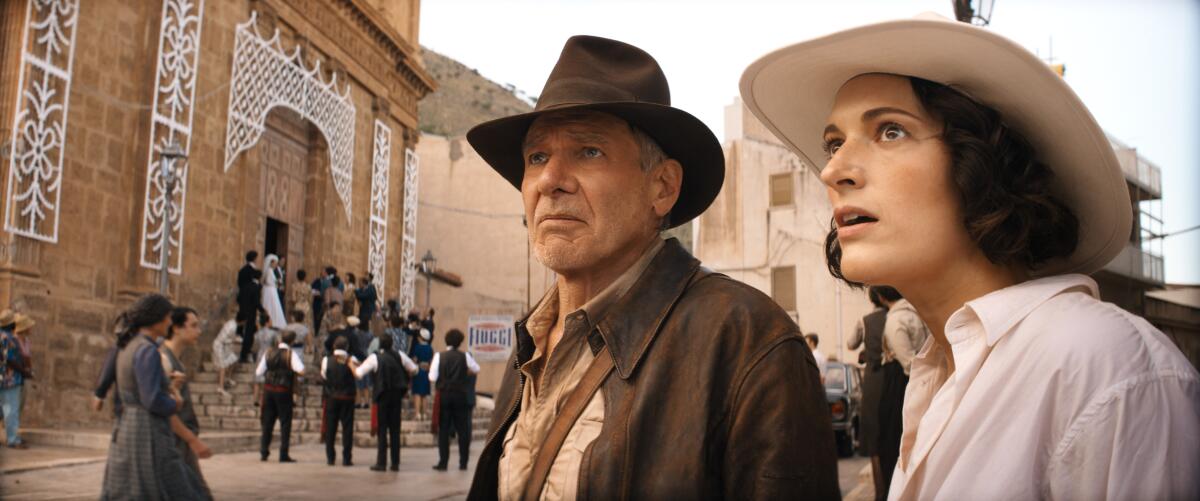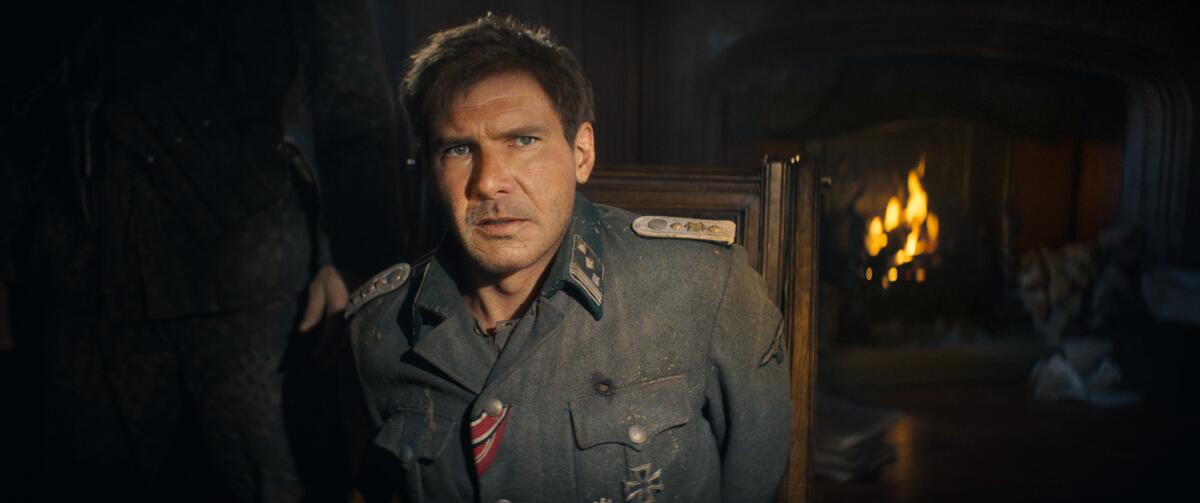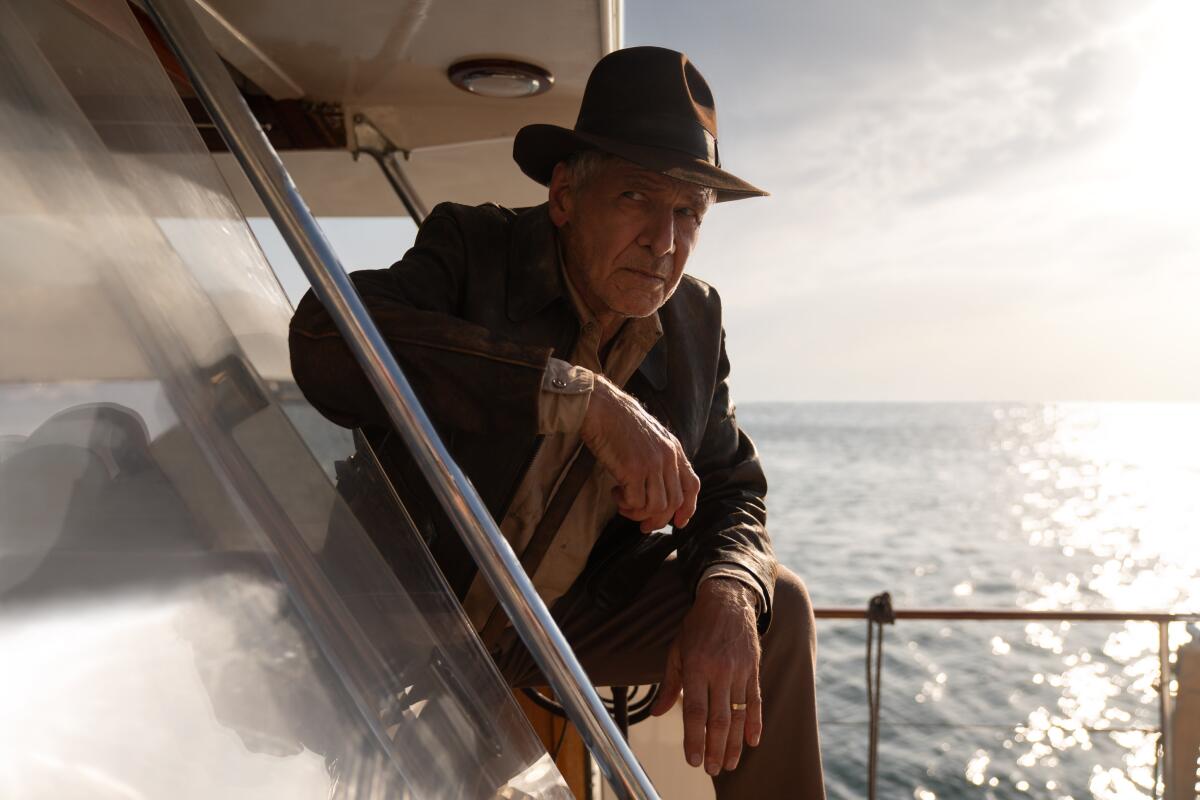With the messy but poignant ‘Dial of Destiny,’ a franchise strains to keep up with the Joneses

- Share via
The first time Harrison Ford appears in “Indiana Jones and the Dial of Destiny,” you can’t take your eyes off him, and not really in a good way. It’s 1944, and Indy, captured while trying to plunder a Nazi stronghold, doesn’t look a day over 46, an illusion that director James Mangold and his 80-year-old star have fostered with the latest and uncanniest in digital de-aging technology. The effects are fairly astonishing, and all the more spookily disorienting for it (why does this Indy look so young but sound so gravelly?). If this is movie magic, it strikes me as magic of a decidedly dark vintage, and not just because of the dim haze that seems to cloud the finer details of cinematographer Phedon Papamichael’s images.
Who or what exactly are we looking at here and why? As Indy hurls himself into a familiar round of death-defying high jinks, you may find yourself scanning the lightly scruffed but artificially smoothed contours of Ford’s mug and wondering precisely that question. It’s still a beautiful mug, of course, and it’s one of the reasons this well-worn series, originally conceived by director Steven Spielberg and creator George Lucas as a kind of parodic homage to the weekend action-adventure serials they loved as children, is still chugging along in its fourth decade. But there’s something jarring about seeing Ford’s face turned, even briefly, into a special effect — an amalgam of images yanked from deep within the Lucasfilm vault, in the latest example of artificial intelligence’s incursion into big-budget moviemaking.
If you find these matters in any way ethically or aesthetically troubling, Mangold (one of the script’s four credited writers, along with Jez Butterworth, John-Henry Butterworth and David Koepp) trusts that you’ll be too caught up in the action to give them more than a passing thought. And maybe caught up in your own nostalgia too: The runaway train that backgrounds the first of Indy’s many high-speed melees also means to transport us swiftly and fondly down memory lane. Here, despite the phony-looking digital scenery, the busy, tension-free action and Spielberg’s absence from the director’s chair, the movie aims to serve up a smorgasbord of familiar Indy blockbuster pleasures. There are jokes to be cracked, Nazis to be punched, explosives to be detonated and ancient artifacts to be discovered and purloined — none more coveted than the Antikythera, a.k.a. the Dial of Destiny, a clock-like instrument that dates back to the time of Archimedes and is rumored to be capable of detecting “fissures in time.”
Cinema being its own nifty time machine, the movie then cuts World War II short and zips ahead to 1969, landing on the sad-sack spectacle of Indy (Ford, now sans digital airbrushing) drinking and languishing away in his New York City apartment. Regret and loss are apparent in every crease in Indy’s weathered face, every fold of his sagging frame. His long career in academia is coming to an end, as is his marriage to his longtime love and fellow explorer, Marion (Karen Allen). As Vietnam War protesters and moon-landing revelers flood the streets beneath his window, his predicament becomes clear: In a world increasingly consumed by present-day perils and future frontiers, what place is there for Dr. Henry Jones, who has always found his greatest excitement, fulfillment and meaning in the past?

It’s an existential question whose cultural and commercial implications can’t help but rebound on this beleaguered franchise: More than four decades after “Raiders of the Lost Ark” (1981) became a smash hit and helped set the template for the contemporary Hollywood blockbuster, is there still a place on our superhero-clogged, action-overloaded movie landscape for the handsome charmer with the fedora, the whip and the dyspeptic grimace? “Dial of Destiny” clearly wants us to believe there is, even if the evidence it marshals over the next 2½ hours proves inconclusive at best and unpersuasive at worst. Funnily enough, the picture is at its best when it casts its own argument into doubt, when it leans poignantly and even self-critically into the notion that time and the movies themselves may well have passed Indy by.
Spielberg had already entertained that possibility — and orchestrated a symbolic passing of the underground-cavern torch — in “Indiana Jones and the Kingdom of the Crystal Skull,” the lucrative but unfondly remembered 2008 film that introduced Shia LaBeouf as Indy’s impetuous long-lost son, Mutt. With Mutt pointedly absent here, the role of quarrelsome foil and possible heir apparent falls to Indy’s goddaughter, Helena Shaw (“Fleabag’s” Phoebe Waller-Bridge), a fast-talking, light-fingered dynamo who shares Indy’s jones for archaeology but has her own playfully duplicitous, mercenary agenda. Before long, Indy and Helena are tossing off second-rate quips and mapping their way from New York to Tangier to the Aegean Sea — all as part of a quest to recover the Dial of Destiny and keep its potentially history-altering powers from falling into the wrong hands.
No hands could be wronger than those of Jürgen Voller (Mads Mikkelsen, solid but predictable), an embittered SS officer who’s determined to rewrite the ending of World War II. Nazis have, of course, long been Indy’s most reliable nemeses, and if their front-and-center villainy here feels like a somewhat rote gesture, it also supplies one of the story’s few points of contact with the real world. (A brief scene in which Voller dresses down a Black hotel worker carries an insinuating chill that the rest of the film doesn’t quite know how to handle.) Mostly, though, the use of Nazis signals an ostensible return to basics, if that’s the word for an elaborate, often tortured series of winks and callbacks to the original Indiana Jones trilogy.
Nearly every beat, every quip, every character dynamic and every outbreak of fisticuffs has its clear antecedent. Teddy (Ethann Isidore), Helena’s plucky juvenile sidekick, is this movie’s version of Ke Huy Quan’s Short Round. Toby Jones does typically fine work as one of Indy’s archaeologist allies, one whose incipient madness sounds an echo of John Hurt’s character from “Crystal Skull.” John Rhys-Davies returns in a few welcome scenes as Sallah, Indy’s faithful pal from “Raiders” and “Indiana Jones and the Last Crusade” (1989). There are the expected diversionary battles, skittering creepy-crawlies and a fresh reminder of Indy’s horror of snakes. There’s also a strangely uncomfortable echo of one of “Raiders’” most famous moments, when a jealous, scimitar-wielding ex-fiancé tries to have his vengeful way with Helena in Tangier.

For the most part, “Dial of Destiny” tries to steer clear of the exoticizing First World gaze and monkey-brained racist stereotyping that has so often marred the series, especially 1984’s “Indiana Jones and the Temple of Doom.” The new picture might have also done well to apply the brakes on its many endlessly attenuated car chases, which, like most heavily green-screened action sequences, are at once high-speed and low-stakes. Only George Miller in full-throttle “Mad Max” mode can really rival Spielberg for this kind of vehicle-hopping mayhem, and Mangold — a solid Hollywood craftsman who’s done strong, genre-straddling work (“3:10 to Yuma,” “The Wolverine,” “Ford v Ferrari”) — never makes the overused action-movie signature his own.
That’s hardly his fault, given the general thanklessness of trying to put a personal stamp on an industrial product as mechanized and fan service-driven as an Indiana Jones sequel. In a way, Indy has been swallowed up by not only the very action-comedy movie formula he helped normalize but also by the dispiriting, depersonalizing trends in 21st-century studio filmmaking. The greatness of “Raiders” and parts of the original trilogy lay in qualities you rarely encounter in movies anymore: their jaunty exuberance, the arresting physicality of their action and the tactile creepiness of their practical effects. And, of course, it also lay, most of all, with Ford, whose persistent stubbornness and equally persistent likability made you want to follow Indy into every booby-trapped fortress, every spider-infested cave and, yes, every underwhelming sequel he came across.
Ford’s sheer movie-star charisma is the one flame this film can’t extinguish. As throwback entertainment, “Indiana Jones and the Dial of Destiny” engages only in fits and starts; its workmanlike script bogs down in tedious treasure hunts and gives mind-boggling short shrift to some of its more intriguing supporting players (Antonio Banderas as a fisherman friend of Indy’s, Shaunette Renée Wilson as a government agent on Helena’s tail). But as a meditation on Indy’s (and Ford’s) mortality, on the passage of time and the plasticity of the motion-picture medium, it’s an unexpectedly, even accidentally resonant piece of work, especially as it gradually finds its footing in the final stretch and sprints toward a loopily audacious climax.

I don’t think it’s entirely coincidental that the fabled Antikythera looks, from certain angles, like a dusty old film-reel canister (talk about rare antiquities). I also can’t deny having shed a few tears over a crucial scene in which Indy, like many an aging movie protagonist, learns to embrace his moment — and to realize that moment was always destined to be fleeting.
His pop-cultural immortality, of course, is more than assured, and it’s in that tension that the sneaky poignancy of “Dial of Destiny” emerges. It’s worth remembering that Spielberg and Lucas dreamed up Indiana Jones, a consummate man of history, as a means of keeping their own favorite chapters of movie history alive, only to wind up making some not-insignificant movie history of their own.
“Dial of Destiny” may wind up little more than a footnote to that history, but that’s not nothing. It’s a muddled if on-brand addendum, a tarnished curio, a not-bad epilogue and, intentionally or not, a lament for the film industry that used to be. Its seamless, largely soulless digital wizardry reminds us of everything Hollywood can do now, and also everything it can’t do anymore and maybe will never do again. It belongs in a museum — which is to say, a movie theater.
——————
‘Indiana Jones and the Dial of Destiny’
Rating: PG-13, for sequences of violence and action, language and smoking
Running time: 2 hours, 34 minutes
Playing: Starts June 30 in general release
More to Read
Only good movies
Get the Indie Focus newsletter, Mark Olsen's weekly guide to the world of cinema.
You may occasionally receive promotional content from the Los Angeles Times.










